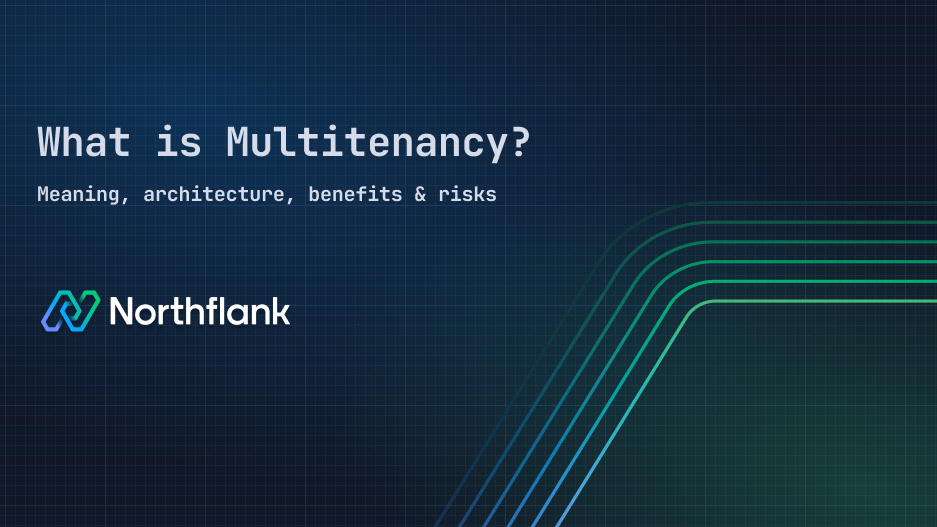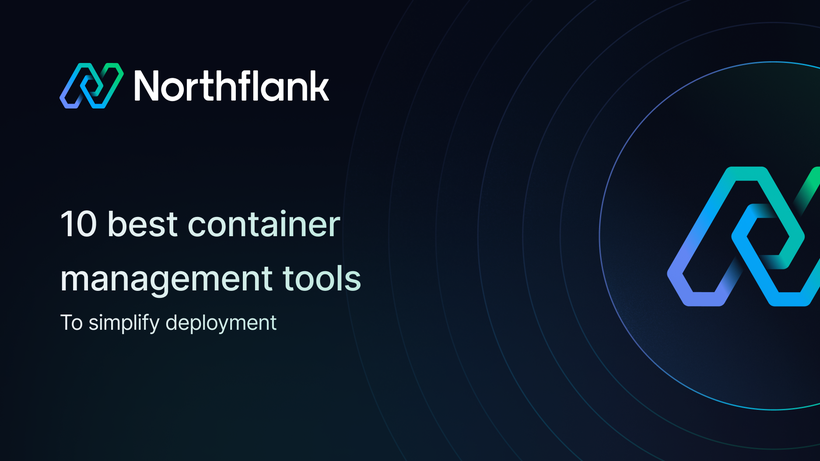

What is Multitenancy? Meaning, architecture, benefits & risks
Multitenancy is the way to run shared infrastructure for many customers without giving up isolation or control. It’s not about giving up security, it’s about getting the right architecture so you don’t waste time and resources duplicating what could be shared.
If you’re working in DevOps, you’re thinking about how to isolate workloads while reusing the same resources. As a platform engineer, you’re trying to simplify operations for your team without locking them into a rigid setup. As a software engineer, you’re looking for a way to build apps that can handle growth without running into constant rebuilds or reconfigurations.
That’s what multitenancy is all about. Let’s break down how it works, what makes it useful, and how you can put it to work in your stack.
This is the short version if you’re skimming:
- What it is: Multitenancy is how you run shared infrastructure for multiple customers while keeping data and workloads separate.
- Why you care: It cuts costs, keeps your deployments fast, and avoids duplicating resources for every new tenant.
- Main benefits: Better resource use, easier updates, and less overhead when you grow.
- Challenges: Risks like resource contention and data isolation, plus the work needed to separate tenants properly.
- How can Northflank help?: Northflank helps you manage multitenant workloads on Kubernetes without doing it all yourself. You get built-in namespace isolation, RBAC, and a secure foundation for tenant-specific environments.
Multitenancy is an architecture pattern that lets you run a single set of resources, like your application code, databases, or underlying infrastructure, to serve multiple customers at the same time. Each of these customers is a tenant. They share the same physical resources, but you keep their data and workloads logically separated.
You can think of each tenant as a user or team that uses your service. They don’t see each other’s data, and they don’t interfere with each other’s performance. That’s the main reason multitenancy works so well when you need to scale without creating new infrastructure for every new tenant.
Each tenant operates in its own isolated environment, even though they all share the same underlying infrastructure. This separation is key to making sure no tenant can access data that isn’t theirs or affect the performance of another tenant’s workload.
A good example is email hosting. When you use a service like Gmail, you’re part of a giant shared system. You share the same backend infrastructure with millions of other users, but your inbox is completely separate. You can’t see anyone else’s data, and they can’t see yours. The application’s logic makes sure your tenant, your inbox, stays isolated.
This shared but isolated setup is at the heart of what makes multitenancy so useful for modern software platforms.
Now that you know what multitenancy is, let’s see how it fits into cloud environments. In cloud computing, multitenancy means using shared physical infrastructure to run workloads for multiple customers. This might be in a public cloud like AWS or Google Cloud, or on a managed platform you run on your own hardware.
For example, if you’re using a Platform as a Service (PaaS) or Software as a Service (SaaS) platform, you’re already working in a multitenant setup. Platforms like Salesforce and Gmail serve thousands of customers from the same codebase and infrastructure. In these systems, each tenant’s data is separated at the software layer, even though they share the same hardware.
This idea also applies to Infrastructure as a Service (IaaS) and containerized environments. If you’re running workloads in Kubernetes, each namespace can be thought of as a separate tenant. Containers or serverless functions share compute resources, but they often share the same kernel, too, which leaves room for noisy neighbor effects and potential side-channel attacks.
Platforms like Northflank address this by using secure runtime isolation based on sandboxing and microVMs. That gives you stronger boundaries between tenants, even for sensitive workloads. I’ll break that down later in the article.
You can see how this looks in practice with the illustration below. It shows how a cloud platform isolates tenants within shared resources:
 How cloud-native multitenancy uses a shared pool of compute and storage while isolating tenants
How cloud-native multitenancy uses a shared pool of compute and storage while isolating tenants
This approach is what lets you run workloads for different customers without spinning up separate infrastructure for each one. It saves resources and simplifies updates, while keeping tenants isolated and secure.
Next, I’ll show you the actual architecture of a multi-tenant cloud environment.
We’ve talked about how multitenancy fits into cloud environments. Now, let’s break down the actual architecture behind it. A multi-tenant cloud architecture is how you set up your app, database, and infrastructure to run multiple tenants in the same environment without leaking data or causing performance issues.
To show how these patterns work, see the diagram below that compares shared app instances, shared databases, and isolated tenant environments:
 Comparing shared app instances, shared databases, separate schemas, and separate databases in multi-tenant architecture
Comparing shared app instances, shared databases, separate schemas, and separate databases in multi-tenant architecture
As you can see in the illustration above, each pattern handles tenant separation differently. Some use shared resources more heavily, while others prioritize isolation for better security and control.
Let’s break down these patterns:
This is where the same application code serves requests for multiple tenants. You see this a lot in SaaS tools where everyone uses the same features and logic. It’s easy to manage at scale because you’re not duplicating deployments, but you still need to handle tenant-specific data separation in your app logic.
All tenants use the same database, but you separate their data with a tenant ID. This pattern saves resources and is easier to manage at first, though it can create challenges as you grow because everything is in one place.
Each tenant has its own schema within a shared database. This adds a layer of isolation without needing separate databases. It’s useful when you want better data separation but don’t want the overhead of managing many database instances.
Each tenant has a completely separate database. This gives you the best isolation and security because tenant data is never stored in the same place. The trade-off is you’ll need to manage and monitor more database instances.
No matter which of these patterns you choose, you need to isolate tenants to keep data secure. Containers and VM-level separation are common approaches for compute resources. In Kubernetes, namespaces keep tenant workloads apart. IAM (Identity and Access Management) locks down who can access each tenant’s data and workloads.
These architectural choices shape how you scale, manage, and secure your multi-tenant environment. Next, I’ll walk you through the benefits that make all this work worth it.
Now that you’ve seen the different ways you can set up a multi-tenant architecture, let’s talk about why you’d want to do it in the first place. Multitenancy brings clear advantages when you’re trying to grow your platform without wasting resources or getting slowed down by constant rework.
Let’s look at some of these advantages:
Because tenants share the same infrastructure, you don’t need to spin up separate environments for every new customer. You’re using your compute, storage, and networking resources more efficiently, which means you’re not paying for unused capacity.
A well-designed multi-tenant system scales with your workload. You can add tenants without deploying a completely new stack for each one. This flexibility means you can grow faster, and your team can focus on improving the core product instead of managing duplicate environments.
When you update your core app or infrastructure, all tenants get the new features or bug fixes at the same time. You’re not managing separate upgrade cycles for each tenant, which cuts down on operational overhead and keeps your platform consistent.
With everyone using the same shared infrastructure, you can balance load across tenants. This helps you avoid wasted resources and makes it easier to tune performance.
These advantages are why multitenancy is so widely used in cloud computing, SaaS, and any platform that needs to serve many customers without sacrificing security or performance.
Next, I’ll walk you through some of the challenges and risks you’ll need to keep in mind as you build out a multi-tenant system.
While multitenancy can save you money and make scaling easier, it’s not without its challenges. When you’re running many tenants on the same shared resources, you need to think carefully about how to keep data secure and performance stable.
When multiple tenants share the same compute, network, or storage resources, one tenant can consume more than their share. This can slow down performance for others and create unpredictable behavior.
You need to make sure no tenant can access data that doesn’t belong to them. If you don’t separate tenants correctly, you open the door to data leaks or targeted attacks. Platforms like Northflank address this by combining runtime isolation with features like encrypted environment variables, RBAC, and container sandboxing. These safeguards create stronger boundaries between tenants, even when workloads share the same physical infrastructure.
If you’re working in regulated environments like finance or healthcare, you need to show how you’re keeping tenant data isolated. Proving that separation can be complex, and you’ll need to document exactly how data is kept safe across tenants.
Because all tenants share the same infrastructure, you can’t always customize the environment for one tenant without affecting others. You need to balance flexibility with stability so that one tenant’s special needs don’t break things for everyone else.
These are the main challenges you’ll face when you move to a multi-tenant setup. Next, I’ll show you how multi-tenancy is implemented in systems and what that looks like in practice.
Let’s get into the technical side of multitenancy. Once you decide to support multiple tenants, you need to figure out how to set it up in your stack. This is where the technical work comes in, and you need to balance security, performance, and maintainability.
Let’s start with a high-level illustration of how multitenancy works across the database, app, and infrastructure layers:
 Diagram showing how multitenancy is achieved through database models, app-level patterns, and infrastructure isolation
Diagram showing how multitenancy is achieved through database models, app-level patterns, and infrastructure isolation
To make multitenancy work, you have to think about how you’ll keep tenant data separate and secure at every layer.
The first decision is how to store tenant data, and there are a few patterns that teams use to solve this. See a breakdown of the main approaches:
- Shared schema: All tenant data sits in the same tables, separated by a tenant ID. This is the simplest and uses the least overhead, but you need to be careful to keep queries scoped to a single tenant.
- Separate schemas: Each tenant has its own schema in the same database. This gives you better isolation without having to manage lots of databases.
- Separate databases: Each tenant gets its own database instance. This is the most secure and isolated, but it also means more operational overhead.
Your application needs to know which tenant is making a request and handle them separately. This might mean using request headers or authentication tokens to identify the tenant. Once you have that tenant ID, your app can load tenant-specific configuration and route requests to the right data.
Beyond the app and database, you also need to separate tenant workloads in the infrastructure. Containers or virtual machines are the usual tools here, but most platforms stop at standard container boundaries. Platforms like Northflank take it a step further by offering out-of-the-box, hardened, sandboxed runtimes and microVM-level isolation, which mitigate privilege escalation risks and improve tenant safety, especially when running untrusted or dynamic code at scale.
In Kubernetes, namespaces are a natural way to split tenant environments and keep them from interfering with each other. Identity and Access Management (IAM) policies control who can see and do what, so one tenant’s users can’t access another tenant’s data or resources.
All of this together is what makes multitenancy possible: clear boundaries in the database, careful tenant-aware logic in the app, and infrastructure controls to keep workloads separate and secure.
Next, I’ll compare single-tenant and multi-tenant approaches so you can see how they differ in terms of complexity, flexibility, and performance.
Now that you’ve seen how multitenancy is put together, let’s see how it compares with single-tenant systems. If you’re choosing how to build or scale your platform, it’s helpful to see the differences side by side.
This table shows a clear breakdown:
| Category | Single-Tenant | Multi-Tenant |
|---|---|---|
| Security | Each customer has a fully isolated environment. | Logical separation is essential to keep tenants’ data secure. |
| Cost | Costs more because every customer has their own environment and resources. | Saves costs by sharing resources like compute and storage across tenants. |
| Flexibility | Easier to customize for each customer’s specific needs. | Less flexibility for individual customization because changes affect all tenants. |
| Operational Complexity | More work to manage separate updates and scaling for each tenant. | Security and isolation need more attention, but updates and scaling are centralized. |
Understanding these differences helps you choose the architecture that works for your team and your platform’s growth.
Next, I’ll give you a concrete example of what multitenancy looks like in practice.
Let’s see what multitenancy looks like when it’s running in the real world. A good place to start is with SaaS platforms you might already use every day. Platforms like Salesforce and Gmail run on multi-tenant architectures. They serve thousands or even millions of customers from the same core system. Each customer’s data and activity are completely separate, but everything runs on shared infrastructure.
You also see multitenancy in cloud-native systems. In Kubernetes, for example, you can use namespaces to isolate tenants while still running them in the same cluster. Namespaces keep workloads and data apart without duplicating the whole environment for each customer. Serverless deployments work the same way. Functions from different tenants share the same runtime but stay logically separate.
These examples show how multitenancy helps you balance security, scalability, and resource usage in modern systems.
Next, I’ll take you through how security works in multi-tenant environments and what you should keep in mind.
Now that you’ve seen how multitenancy works in practice, let’s talk about the security side of it. Keeping tenant data separate and secure is one of the most important parts of any multi-tenant architecture.
A big piece of this is Identity and Access Management (IAM). IAM lets you control who can access which resources and data. In a multi-tenant system, you need to make sure tenant admins and users can only see their own data and workloads.
You also need to think about encryption. Data should be encrypted when it’s stored (at rest) and when it’s moving between systems (in transit). This keeps data safe even if someone gets access to the underlying hardware.
Network isolation is another layer of protection. Tenants should be separated at the network level, so one tenant can’t accidentally or intentionally send traffic to another tenant’s environment.
To show how these security layers work together in a typical cloud-native platform, see this illustration:
 Diagram showing IAM, encryption at rest and in transit, and network segmentation in a multi-tenant cloud environment
Diagram showing IAM, encryption at rest and in transit, and network segmentation in a multi-tenant cloud environment
Best practices for multi-tenant security also include clear monitoring, logging, and continuous updates. You need to be able to track who’s doing what, and react quickly if you spot something unusual.
Getting security right in a multi-tenant system is a shared responsibility between the platform and the tenants. The goal is to give each tenant the flexibility to grow without giving up control of their own data.
Next, I’ll show you how Northflank handles multi-tenant workloads so you don’t have to build all of this from scratch.
When you’re dealing with multitenant workloads, it’s not just about spinning up containers. You need to isolate tenants at the namespace level, manage access to shared resources with precision, and keep an eye on everything without compromising performance or security. That’s where Northflank comes in: it gives you built-in multitenant support that works right out of the box, without relying on separate tools or complex scripts.
Let’s see how.
Let’s say you’re running a SaaS platform where each customer needs a fully isolated environment to meet security, compliance, and performance needs. With Northflank, you can create a dedicated namespace for each tenant, apply strict RBAC policies, and manage them all from a single control plane. You’re giving each tenant their own environment with clear boundaries. No accidental cross-tenant access and no compromise on performance. It’s multitenancy done right.
Namespace isolation is one of the key building blocks of secure multitenancy. On Northflank, you can restrict access to specific namespaces for your linked Git accounts and services. This means each tenant has a slice of the platform that’s fully theirs, without noise or overlap.
Under the hood, Northflank reinforces this isolation with features like gVisor and Kata Containers for nested virtualization, adding another layer of security around each tenant’s runtime. Network isolation is handled with Cilium and Kubernetes NetworkPolicies to prevent cross-namespace or cross-project communication.
If your workloads need trusted communication between services, Northflank’s built-in service mesh with mutual TLS (mTLS) enforces strict authentication and encryption between tenants’ services.
You can learn more about how this works in Northflank’s documentation on restricting namespaces.
Controlling access at scale isn’t optional. Northflank uses role-based access control (RBAC) to give you fine-grained permissioning across your multitenant setup. You can define roles like owner, admin, or default, and assign them to users or groups. This way, you decide exactly who can deploy services, manage secrets, or view activity logs, reducing the risk of accidental or malicious changes.
You can see how easy it is to configure RBAC in Northflank’s RBAC guide.
See how RBAC is implemented in Northflank, showing project-specific restrictions for better control and security.
 A detailed look at Northflank’s RBAC configuration interface, where roles can be restricted to specific projects and teams to maintain secure, multitenant environments.
A detailed look at Northflank’s RBAC configuration interface, where roles can be restricted to specific projects and teams to maintain secure, multitenant environments.
When you’re running multitenant workloads, you need complete visibility. Northflank’s governance and monitoring features give you a single place to manage everything. You get:
- Centralized control over billing, security, and team access
- Audit logs that track activity across teams and projects
- Tools to manage Git integrations and restrict namespaces
It’s all in one place, so you’re not left in the dark about potential issues. See more in the collaboration and governance docs.
For platform engineers and DevOps teams, this means you spend less time configuring separate tools and more time delivering reliable, secure services. For software teams, you get confidence that every customer environment is secure and isolated, with no accidental leaks or misconfigurations.
Multitenancy can be complex, but it doesn’t have to be a burden. With Northflank’s built-in support for namespace isolation, RBAC, and centralized governance, you can focus on running your workloads at scale, securely, and with complete control.
You might still have questions about how multitenancy works in practice. Let’s clarify some of the most common questions.
1. What is the meaning of multitenancy?
Multitenancy means that a single platform or environment serves multiple independent users or teams, called “tenants,” sharing the same underlying resources but staying isolated from each other.
2. What is multi-tenant with an example?
A multi-tenant system like Northflank allows you to run separate environments for different teams or clients within the same cluster, so each team’s resources are isolated and managed independently.
3. What are the advantages and disadvantages?
Multitenancy lowers costs and improves resource usage by sharing infrastructure. However, it can introduce security and data risks if not isolated properly.
4. What is the difference between single-tenant and multi-tenant?
Single-tenant systems dedicate an entire environment to one user, while multi-tenant systems share infrastructure across tenants, adding more flexibility and better cost efficiency.
5. What are the risks of multitenancy?
The biggest risks are data leakage and resource contention between tenants. That’s why secure role-based access control, strong namespace isolation, and careful governance are critical.
We’ve covered how Northflank’s built-in tenancy workflows, namespace isolation, and RBAC-based security can help you manage multitenant workloads with clarity and control. The key takeaway is that multitenancy isn’t just a feature. It’s a way to ensure secure, isolated environments that align with your team’s scaling needs.
If you’d like to continue refining your approach:
- You can check out Northflank’s tenancy workflows in your projects or see detailed guidance in the Northflank documentation.
- For an in-depth look at container isolation and secure workloads, read this blog post on container isolation and micro-VMs.
- When you’re ready to set things up, you can sign up and see how tenancy management fits your stack.


